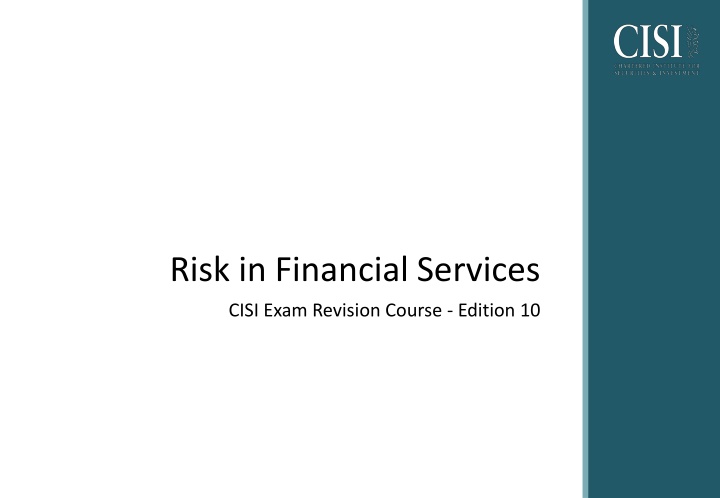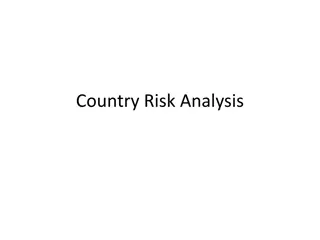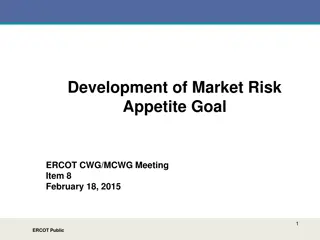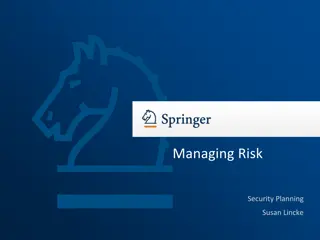Risk in Financial Services
Dive into the fundamental principles of risk management in the financial services industry. Explore key risks, regulatory influences, and strategies for identifying, mitigating, and managing risk. Learn about various types of risks such as credit, market, liquidity, and operational risks. Understand the importance of corporate governance and risk oversight in mitigating external and internal risks. Discover tools and methods for assessing risks and uncertainties, including PESTLE analysis and ESG factors.
Download Presentation

Please find below an Image/Link to download the presentation.
The content on the website is provided AS IS for your information and personal use only. It may not be sold, licensed, or shared on other websites without obtaining consent from the author.If you encounter any issues during the download, it is possible that the publisher has removed the file from their server.
You are allowed to download the files provided on this website for personal or commercial use, subject to the condition that they are used lawfully. All files are the property of their respective owners.
The content on the website is provided AS IS for your information and personal use only. It may not be sold, licensed, or shared on other websites without obtaining consent from the author.
E N D
Presentation Transcript
Risk in Financial Services CISI Exam Revision Course - Edition 10
Objective of the Qualification The objective of the examination is to ensure that candidates have a broad understanding of the following: The general principles of risk in business The key risks that arise within the financial services industry The influence of corporate governance, regulation and codes of conduct The approaches that are typically used to identify, reduce and manage specific aspects of risk
Workbook Chapters Principles of Risk Management International Risk Regulation Operational Risk Credit Risk Market Risk Investment Risk Liquidity Risk Model Risk Risk Oversight and Corporate Governance 1. 2. 3. 4. 5. 6. 7. 8. 9. 10. Enterprise Risk Management (ERM) 3
Principles of Risk Management Chapter 1
Risk management The practice of using processes, methods and tools for quantifying and managing risks and uncertainties Identifying what could go wrong Evaluating which risks should be dealt with Implementing strategies to address those risks Risk versus uncertainty Risk is the variability that can be quantified Uncertainty is the variability that cannot be quantified 5
Risk in Financial Services Credit, market and liquidity risk Investment risk Operational risk Enterprise risk Strategic risk - Internal and External Corporate governance and risk oversight 6
External Sources of Risk Economic Political Competitive environment Social and market forces Technological and Cyber Security Risk Shocks and natural events External stakeholders and third parties Environmental, Social and Governance risks (ESG) 9
Assessing External Risks Other Business Continuity Planning Planning for disaster recovery and business continuity will uncover external risks Business Process Analysis involving Examination of each high-level business process Description the internal processes and external factors that can influence those business processes. 10
Key Internal Risk Drivers Strategic risk Is the strategy right? Is the strategy properly implemented? Operational risk The risk of loss arising from processes, people, systems or external events Financial risk Credit risk Market risk Liquidity risk 11
Assessing Internal Drivers of Risk Risk assessment workshops Discussion with external auditors Stress testing Scenario analysis 12
Overlapping Nature of External and Internal Drivers External and internal risk drivers often overlap Example: development and launch of new products Internal risks include strategic, operational, compliance and financial risks External risks include the economic climate and the competitive environment Possible methods to reduce new product risk Gap analysis Market survey Research and development 13
Concepts of Risk Risk culture and conduct risk Risk appetite Inherent (gross) risk Residual (net) risk Risk profile Risk mitigation Reputational risk 14
Adding Value Cost/benefit analysis - actual cost vs likely revenues Include potential risks when assessing new strategies/products Involvement in early stage of product development Reduce likelihood of unexpected outcomes on day-to-day basis results in reduction of earnings volatility and enhance firm s share price 15
Specific Risks in Financial Services Bank for International Settlements defines the following: Operational risks Credit risk Market and asset liquidity risk Funding liquidity risk Interest rate risk Systemic risk: Risk to one firm can affect stability of whole financial system Recovery and resolution plans required 16
Emerging Risks in Financial Services Technology in finance and regulations Digital Assets, Cryptocurrencies and Smart Contracts Financial crime Cyber and data security Custody Market risk Business and reputational risks 18
International Risk Regulation Chapter 2
Bank for International Settlements Established in 1930 Bank of central banks International monetary and financial co-operation Headquartered in Basel in Switzerland Regulatory guidelines do not have force in national or international law Countries can choose to implement via law and/or regulations 20
Basel Committee (BCBS) Enhance understanding of supervisory issues and improve the quality of banking supervision worldwide Basel Accords 3 pillars Minimum calculation of capital Firm s own view on capital adequacy and supervisory review Public disclosures 21
Basel Committee (BCBS) Standards on capital adequacy to ensure firms hold enough capital to overcome adverse movements Additional concepts beyond capital adequacy (Basel IV) Countercyclical capital buffer Leverage ratio Liquidity requirements/ratios 22
Core Principles National preconditions to provide a framework for effective supervision Sound and stable macro economic policies Framework for financial stability policy formulation Public infrastructure Framework for financial crisis management. recovery and resolution Systemic protection or public safety net Effective market discipline 29 Core principles 1-13: Supervisory powers, responsibilities and functions 14-29: Supervisory expectations of banks, emphasising importance of good corporate governance and risk management 23
Basel Regulatory Capital Sound practice principles Covering a range of aspects of risk management Practical guidance for firms Specific areas for regulators to address in supervisory role Pillar 2 Assessment - Internal Capital Adequacy Assessment Process (ICAAP) Firm s risk exposure Firm s view on adequacy of its risk management processes Firm s financial and capital plans Stress and scenario tests applied to risks and financial plans The firm s capital and liquidity adequacy Use-test Setting the regulatory capital and liquidity level 24
Home Host State Regulation Multi jurisdiction supervision Home state: Home or parent regulator Host state: Regulators in countries where the firm has branches Parent banks and supervisors are ultimately responsible Key principles Supervision by home supervisor Cross border institution needs to have approval from home and host Home countries have information gathering rights Host may impose restrictive measures 25
Principles-based regulation Rules based or statutory approach based on specific legal rules, eg US SEC Principles based regulation specifies general types of behaviour expected National regulator responsibility Day-to-day regulatory relationship with firms Regulate for the risk a firm presents to the regulator s statutory objectives Risk Management and Control Consumer protection Business standards Regulatory standards 26
Reviews and Risk Assessment Visits Baseline monitoring activities: Analysing financial and other returns Generally assessing management, governance and culture, control functions, capital and liquidity Supervisory intensity based on risk impact and probability scores For firms with significant retail or wholesale businesses: Customers Products Markets For firms with permission to hold or control client money: Arrangements for safeguarding 27
Other relevant regulation Effects of breach of law 1. Reputational risk 2. Withdrawal of regulatory authorisation (sanction) 3. fines and penalties 4. Criminal and civil liability 5. Loss of staff Identify all relevant laws Mitigate risk of inadvertently breaking the law 28
Operational Risk Chapter 3
Basel Committee Operational Risks Definition: The risk of loss resulting from inadequate or failed internal processes, people and systems or from external events Includes legal risks, but excludes reputational risk Risk event types Internal fraud (IF) 1. External fraud (EF) 2. Employment practices and workplace safety (EPWS) 3. Clients, products and business practices (CPBP) 4. Damage to physical assets (DPA) 5. Business disruption and system failures (BDSF) 6. Execution, delivery and process management (EDPM) 7. 30
Operational Risk Relatively difficult to identify and put a value to Operational Risk as a Distinct Risk Class Operational risk materialises, often causes other risk issues too: Reputational risks Compliance (or regulatory) risks Credit risks Market risks Liquidity risks Investment risks 31
Operational Risk Policy Document outlining the firm s strategy and objectives for operational risk management Identification of key officers Define clear roles and responsibilities Segregation of duties Cross-functional involvement and agreement Operational risk management function Identification and assessment of risk Risk management and mitigation techniques Benchmarking good industry practice Provide risk oversight and monitoring Ensure issues are escalated Conduct quantitative/statistical modelling on risk events Statistical modelling 32
Operational Risk Identification Identifying and categorising operational risks helps the firm establish their risk profile and appetite for risk Risks are typically categorised as follows: Process risks eg, lack of written procedures or absence of escalation procedures People risks eg, inadequate definition of roles and responsibilities or staff not competent for the role System risks eg, denial of service attacks, or data corruption Vulnerability to external events eg, threat of terrorist action or customer fraud Self assessment departmental managers and staff score risks Subjective Individual risk scores to be combined in a single final score 34
Application 35
Operational Risk Assessment and Measurement Understanding the likelihood of risks occurring and the potential impact on the business Establishes a quantitative baseline for improving the control environment Major difficulty is the lack of relevant and objective data Risk measurement Uses quantitative techniques to understand the size of a firm s or business area s risk profile Risk assessment Estimates the impact on the business Uses objective and/or subjective data 36
Methods of Assessment Impact and likelihood assessment Likelihood probability 1 = very low, 2 = low, 3 = medium and 4 = high Impact loss rating Impact is the potential loss such as under 1,000 = 1, 1,000 to 10,000 = 2, 10,000 to 50,000 = 3, over 50,000 = 4 Risk Score Likelihood score x impact score 37
Scenario and Bottom-up Scenario Analysis Top down method Uses experience of business professionals to capture possible scenarios Scenarios are investigated, and preventative measures can be taken Bottom up analysis Builds up a detailed profile of the risks that occur in each area Aggregates them to provide risk exposures for departments, divisions and the whole firm Uses a combination of experience of the managers and staff along with loss data Resultant measure contains both qualitative and quantitative elements 39
Key Risk Indicators (KRIs) Method of measuring operational risk Taking the key risks from the operational risk assessment and identifying indicators Indicators will ideally be forward looking and predictive Identify periods of increased operational risk before losses start occurring 40
Historical Loss Data Important in mapping actual losses experienced back to the categorisation system Allows for creation on loss distribution curve Analysis to predict future losses within specified confidence limits Shape of the curve is often fat tailed and not normally distributed extremely high impact losses occur very rarely 41
Practical Constraints Data collection constraints Lack of data, system constraints and lack of standardisation make it difficult to build a comprehensive data set Cultural constraints Business heads need to be convinced of the value Resource and cost constraints Firms commonly underestimate the time and resource requirement Indicator constraints Difficult to design risk indicators that monitor the full range of risks 43
Risk Register Also known as Risk Log List of risk identified including part of business Assign owners to each risk Define risk mitigation Period re-evaluation of risks on the register and the effectiveness of the risk mitigants 44
Managing Operational Risk Transfer to third party Avoid Mitigate Accept 45
Operational Risk Mitigation Controls Financial Crime Prevention Operational Resilience Outsourcing Insurance Information, Cyber Security, Data Protection and Privacy Physical Security Financial Reserves Risk Awareness Training 46
Operational Loss Data Measurement Escalation thresholds Loss Causal Analysis Understanding of the underlying causes of the loss Address route cause will ensure the issue has a lower likelihood of recurring 47
Credit Risk Chapter 4
Credit Risk Risk of loss caused by the failure of an obligor to meet its obligations Main types of credit risk Counteparty risk Issuer risk Concentration risk risk resulting from uneven distribution of exposures Individual issuers Industry sectors Geographical locations Systemic risk Break down of the entire financial system 49
Credit Risk Measurement Credit exposure the amount that can potentially be lost if a debtor defaults Current exposure Potential future exposure Credit risk premium difference between the interest rate paid by a firm and the rate paid on a default risk free security (eg government bond) Credit rating expression of a firm s credit worthiness and financial health, often by an independent credit ratings agency 50























